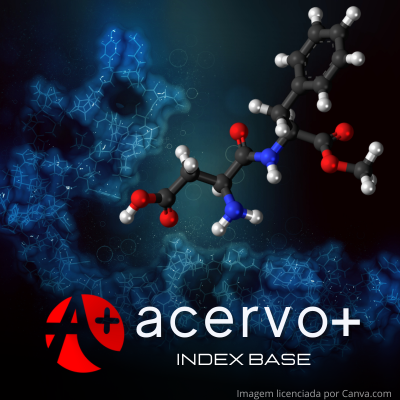Glicosaminoglicanos como biomarcadores de doenças: uma revisão sistemática
##plugins.themes.bootstrap3.article.main##
Resumo
Objetivo: Identificar os glicosaminoglicanos (GAGs) como biomarcadores preditivos de processos biológicos normais, processos patológicos e intervenções diagnósticas não-invasivas. Métodos: Foram realizadas buscas nas bases de dados Acervo+ Index base, Scopus, MEDLINE, Web of Science, SciELO e LILACS e incluídos os estudos originais que abordam o uso de GAGs como biomarcadores em diagnósticos de doenças. Para a análise crítica dos estudos selecionados, foi aplicado o método QUADAS-2 como ferramenta de avaliação da qualidade metodológica. Resultados: Foram selecionados 66 artigos potencialmente relevantes, os quais 20 atendiam os critérios de elegibilidade. Após avaliação da qualidade metodológica, foram incluídos 10 estudos classificados com nível baixo no risco de viés para a síntese narrativa e 1 artigo experimental que estuda o mecanismo da GAG na fibrose hepática. Considerações finais: A presente revisão sistemática, identificou que o uso de GAGs como biomarcadores apresenta boa reprodutibilidade, podem ser empregados em procedimentos não invasivos (sangue ou urina), ser realizados na maior parte dos laboratórios e, permitem a avaliação do progresso e dos processos fisiopatológicos. Contudo, ainda possui limitações para diferenciar estágios intermediários em algumas doenças.
##plugins.themes.bootstrap3.article.details##
Copyright © | Todos os direitos reservados.
A revista detém os direitos autorais exclusivos de publicação deste artigo nos termos da lei 9610/98.
Reprodução parcial
É livre o uso de partes do texto, figuras e questionário do artigo, sendo obrigatória a citação dos autores e revista.
Reprodução total
É expressamente proibida, devendo ser autorizada pela revista.
Referências
2. AMENDUM PC, et al. Glycosaminoglycans as Biomarkers for Mucopolysaccharidoses and Other Disorders. Diagnostics, 2021;11(9): 1563.
3. BRATULIC S., et al. Noninvasive detection of any-stage cancer using free glycosaminoglycans. PNAS, 2022; 119(50): e2115328119.
4. COULSON-THOMAS YM, et al. The Identification of Proteoglycans and Glycosaminoglycans in Archaeological Human Bones and Teeth. PLoS ONE 10(6): e0131105.
5. D’AVANZO, F, et al. Mucopolysaccharidosis Type VI, an Updated Overview of the Disease. International Journal of Molecular Sciences, 2021; 22(24): 13456.
6. DREYFUSS JL, et al. Heparan sulfate proteoglycans: structure, protein interactions and cell signaling. Anais da Academia Brasileira de Ciências, 2009; 81(3): 409-429.
7. FISHEL S, et al. LMWH in IVF – Biomarkers and benefits. Thrombosis Research, 2017; 151(1): S65–S69.
8. GATTO, F, et al. Plasma and Urine Free Glycosaminoglycans as Monitoring and Predictive Biomarkers in Metastatic Renal Cell Carcinoma: A Prospective Cohort Study. JCO Precision Oncology, 2022; 7: e220036.
9. GATTO, F, et al. Plasma Glycosaminoglycans as Diagnostic and Prognostic Biomarkers in Surgically Treated Renal Cell Carcinoma. European Association Urology, 2018; 1: 364-377.
10. HERBST ZM, et al. Evaluation of Two Methods for Quantification of Glycosaminoglycan Biomarkers in Newborn Dried Blood Spots from Patients with Severe and Attenuated Mucopolysaccharidosis Type II. International Journal of Neonatal Screening, 2022; 8(1): 9.
11. JAKOBKIEWICZ-BANECKA J, et al. Glycosaminoglycans and mucopolysaccharidosis type II. Frontiers in Bioscience, 2016; 21: 1393-1409.
12. KANTARCIOGLU B, et al. Predictive Role of Blood Cellular Indices and Their Relationship with Endogenous Glycosaminoglycans as Determinants of Inflammatory Biomarkers in Pulmonary Embolism. Clinical and Applied Thrombosis/Hemostasis, 2022; 28: 1-11.
13. KHAN SA, et al. Advances in glycosaminoglycan detection. Molecular Genetics and Metabolism, 2020; 130(2): 101-109.
14. KHAN SA, et al. Glycosaminoglycans analysis in blood and urine of patients with mucopolysaccharidosis. Molecular Genetics and Metabolism, 2018; 125(1-2): 44-52.
15. LIN Y, et al. The relationships between urinary glycosaminoglycan levels and phenotypes of mucopolysaccharidoses. Molecular Genetics & Genomic Medicine, 2018; 6(6): 982-999.
16. MARTEL-PELLETIER J, et al. Levels of serum biomarkers from a two-year multicentre trial are associated with treatment response on knee osteoarthritis cartilage loss as assessed by magnetic resonance imaging: an exploratory study. Arthritis Research & Therapy, 2017; 19: 169.
17. MENEGHETTI MCZ, et al. Heparan sulfate and heparin interactions with proteins. Journal of The Royal Society Interface, 2015; 12: 20150589.
18. MOHER D, et al. Preferred reporting items for systematic reviews and meta-analyses: the PRISMA statement. Plos Medicine, 2009; 6(7): e1000097.
19. NAKAMURA-UTSUNOMIYA A. Bone Biomarkers in Mucopolysaccharidoses. International Journal of Molecular Sciences, 2021; 22(23): 12651.
20. NASCIMENTO PCH, et al. Glycosaminoglycans and proteoglycans in palmar fascia of patients with Dupuytren, Acta Ortopédica Brasileira, 2016; 24(2): 98-101.
21. NEUFELD EF e MUENZER J. The Mucopolysaccharidoses. In: VALLE et al. (Eds). The Online Metabolic and Molecular Bases of Inherited Disease. McGraw Hill, 2019.
22. NEUMAN MC, et al. Hyaluronic acid as a non-invasive biomarker of liver fibrosis. Clinical Biochemistry, 2016; 40: 302-315.
23. RODRIGUES LMR, et al. Inflammatory biomarkers in sera of patients with intervertebral disc degeneration. einstein (São Paulo). 2019; 17(4): eAO4637.
24. SABIR E, et al. Usefulness of urinary glycosaminoglycans assay for a mucopolysaccharidosis-specific screening. Pediatrics International, 2020; 62: 1077–1085.
25. DOS SANTOS PRD, et al. Effects of shock wave therapy on glycosaminoglycan expression during bone healing. International Journal of Surgery, 2015, 24: 120-123.
26. SINGH T, et al. Emerging Approaches for Fluorescence-Based Newborn Screening of Mucopolysaccharidoses. International Journal of Molecular Sciences – Diagnostics, 2020; 10: 294.
27. SZEREMETA A, et al. Effects of a 15-month anti-TNF-α treatment on plasma levels of glycosaminoglycans in women with rheumatoid arthritis. Arthritis Research & Therapy, 2018; 20: 211.
28. UETA RHS, et al. Effects of training and overtraining on intervertebral disc proteoglycans. Spine (Phila Pa 1976), 2018; 43(1): E1-E6.
29. WATANABE MS, et al. Extracellular matrix alterations in the Peyronie’s disease. Journal of Advanced Research., 2017; 8: 455-461.
30. WHITING P, et al. The development of QUADAS: a tool for the quality assessment of studies of diagnostic accuracy included in systematic reviews. BMC Medical Research Methodology, 2003; 3: 25.
31. YANG YM, et al. Hyaluronan synthase 2–mediated hyaluronan production mediates Notch1 activation and liver fibrosis. Science Translational Medicine 2019; 11(496): 1-27.

